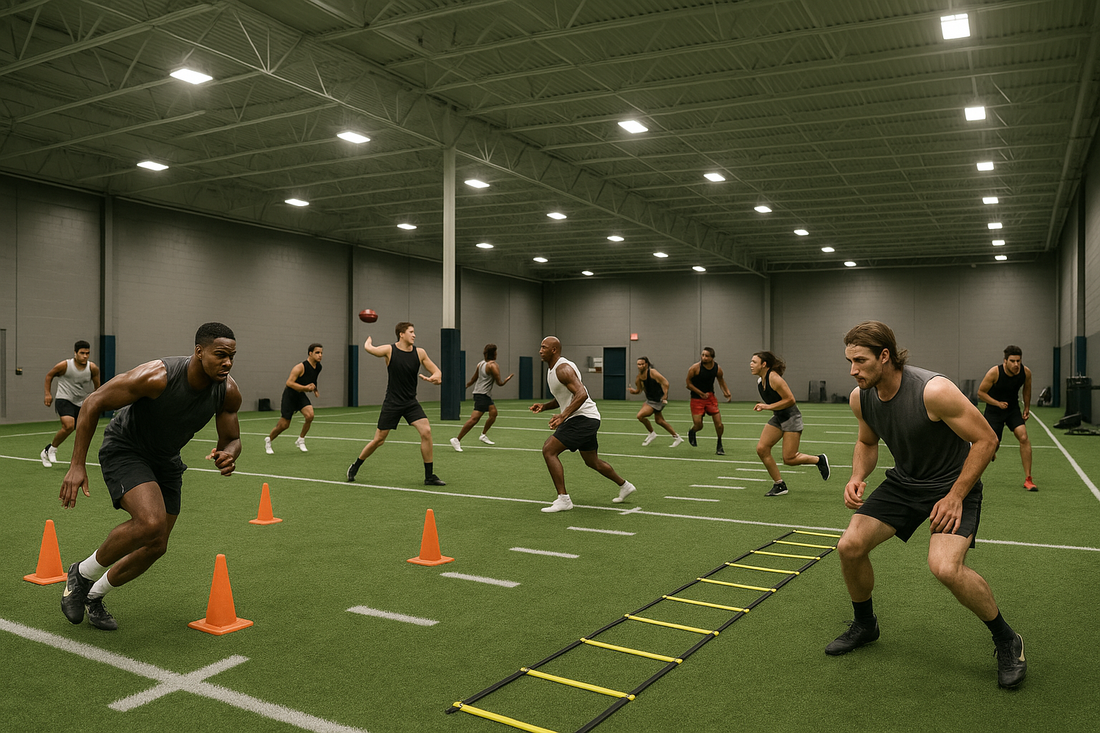
Building Tomorrow’s Champions: A Guide for Parents and Coaches on Youth and High School Football Development
Share
In a world where tomorrow’s champions are being molded on the football field, it’s crucial for young athletes to focus on the essentials of training, practice, and recovery. For youth and high school players, mastering the fundamentals of the game is just the beginning; it’s about developing a deep understanding of every play and move until they become second nature. Parents and coaches play a pivotal role in guiding these next generation athletes, ensuring they not only practice hard but also recover wisely to maximize their potential. With the right balance of dedication and style, players can express themselves with confidence on the field, embodying both skill and swag. This guide will walk you through the importance of youth football training, high school football practice, and essential football recovery tips to help young players shine and dominate the game.
The Foundation of Success: Youth Football Training
Building Blocks for Future Stars
Youth football training is where it all begins. Young players need to focus on mastering the basics. This includes proper stance, ball handling, and footwork. Coaches should create fun, engaging drills that teach these skills. Parents can support by encouraging practice at home. It’s important to keep training sessions short and varied to maintain interest. As players progress, they can start learning more complex plays and strategies. The goal is to build a strong foundation that will serve them well as they advance in their football careers.
Creating a Positive Training Environment
A positive training environment is key for youth football. Coaches should focus on praise and constructive feedback. This helps build confidence in young players. It’s also important to teach good sportsmanship and teamwork. Parents can contribute by being supportive from the sidelines. They should avoid putting too much pressure on their children. The aim is to foster a love for the game that will keep players motivated to improve.
Stepping Up the Game: High School Football Practice
Intensity and Precision in Training
High school football practice takes things to the next level. The intensity of training increases significantly. Players need to be prepared for longer, more demanding sessions. Coaches should focus on developing stamina and strength alongside skill. It’s crucial to incorporate proper warm-up and cool-down routines. This helps prevent injuries and improves recovery. High school players should also start learning more advanced tactics and plays. Film study becomes an important part of practice at this level.
Balancing Academics and Athletics
High school football players face the challenge of balancing academics and athletics. Coaches and parents need to stress the importance of education. Good grades should be a requirement for playing time. Time management skills become crucial. Players need to learn how to juggle schoolwork, practice, and games. Coaches can help by scheduling practices that don’t interfere with study time. Parents can support by creating a structured environment at home that allows for both study and training.
Recovery: The Secret Weapon for Football Success
Essential Football Recovery Tips
Recovery is often overlooked but it’s crucial for football success. Players need to understand the importance of rest and proper nutrition. After intense practices or games, players should focus on stretching and cool-down exercises. Ice baths or contrast therapy can help reduce muscle soreness. Proper hydration is key, both during and after physical activity. A balanced diet rich in proteins and carbohydrates aids in muscle recovery. Adequate sleep is also essential for both physical and mental recovery.
Mental Recovery and Stress Management
Physical recovery is important, but mental recovery is equally crucial. Football can be stressful, especially at higher levels. Players need to learn stress management techniques. This can include meditation, visualization, or simply talking about their concerns. Coaches and parents should be open to discussing mental health. Creating a supportive environment where players feel comfortable expressing their feelings is vital. This helps prevent burnout and keeps players motivated throughout the season.
Expressing Yourself on the Field: Football Swag and Style
Confidence Through Personal Style
Football isn’t just about skill; it’s also about style. Players should be encouraged to express themselves on the field. This can be through their playing style or even their equipment choices. Allowing players to have some input in team gear can boost morale. However, it’s important to balance individual expression with team unity. Coaches should set guidelines that allow for personal flair within team norms. This helps players feel confident and unique while still being part of a cohesive unit.
The Link Between Looking Good and Playing Well
There’s a psychological boost that comes from feeling good about how you look on the field. When players feel confident in their appearance, it often translates to better performance. This doesn’t mean focusing solely on aesthetics, but rather finding a balance. Proper-fitting, high-quality gear can make a big difference. It not only looks good but also enhances performance and safety. Encourage players to take pride in their appearance and equipment care. This attention to detail often carries over into their play on the field.
The Path to Domination: Putting It All Together
Consistent Effort and Dedication
Dominating on the football field doesn’t happen overnight. It’s the result of consistent effort and dedication. Players need to understand that success comes from the cumulative effect of proper training, practice, and recovery. Coaches should emphasize the importance of showing up every day ready to work. Parents can support by ensuring players have the resources they need to maintain this dedication. It’s about building good habits that will serve players well throughout their football careers and beyond.
Setting and Achieving Goals
Goal-setting is a powerful tool for football players at any level. Coaches should work with players to set both short-term and long-term goals. These goals should be specific, measurable, and achievable. Regular check-ins on progress help keep players motivated. Parents can support by acknowledging and celebrating these achievements. As players reach their goals, they gain confidence and are more likely to push themselves further. This cycle of setting and achieving goals is what leads to true domination on the field.## Training and Recovery Importance
The foundation of any successful football career starts with proper training and recovery. This section explores the essentials of youth football training, high school practice routines, and crucial recovery tips that can make or break an athlete’s performance.
Youth Football Training Essentials
Youth football training is all about building a strong foundation. USA Football’s practice guidelines emphasize the importance of age-appropriate drills and techniques.
For young players, focus on basic skills like proper stance, ball handling, and footwork. These fundamentals are crucial for future success on the field.
Incorporate fun, engaging drills that teach these skills while keeping players interested. Short, varied sessions work best for maintaining focus and enthusiasm.
As players progress, gradually introduce more complex plays and strategies. This stepwise approach helps build confidence and prevents overwhelm.
Remember, the goal is to foster a love for the game that will keep young athletes motivated to improve and stick with football long-term.
High School Football Practice Routines
High school football practice takes training to the next level. The University of Tennessee’s high school football training guide offers valuable insights into structuring effective practice sessions.
Intensity and duration of practices increase significantly at this level. Players need to be prepared for longer, more demanding workouts that build both skill and stamina.
Incorporate a mix of individual skill work, team drills, and scrimmages. This variety helps players develop a well-rounded skill set and understand game situations better.
Don’t forget the importance of film study and tactical discussions. These off-field activities are crucial for developing football IQ and strategic thinking.
Coaches should also focus on position-specific training to help players excel in their roles and contribute effectively to the team’s success.
Football Recovery Tips for Success
Recovery is a critical but often overlooked aspect of football training. Proper recovery techniques can prevent injuries, improve performance, and extend an athlete’s career.
Prioritize sleep: Aim for 8-10 hours of quality sleep each night to allow the body to repair and regenerate.
Hydrate consistently: Drink water throughout the day, not just during practice or games.
Eat a balanced diet: Focus on lean proteins, complex carbohydrates, and plenty of fruits and vegetables.
Incorporate active recovery techniques like light jogging or swimming on rest days. These activities promote blood flow without overstressing the body.
Don’t underestimate the power of stretching and foam rolling. These practices can significantly reduce muscle soreness and improve flexibility.
Expressing Style on the Field
Football isn’t just about skill; it’s also about confidence and personal style. This section explores how players can express themselves on the field while maintaining team unity and boosting their performance.
Football Swag and Style
Football swag is about more than just looking good; it’s about feeling confident and ready to perform at your best. Youth Football Online’s guide for parents emphasizes the importance of proper equipment fit and style.
Choose gear that not only meets safety standards but also reflects your personal style. Many brands offer customizable options for cleats, gloves, and other accessories.
Remember that team unity is crucial. Work with your coach to find ways to express individual style within team guidelines.
Football Swag and Style
Football swag is about more than just looking good; it's about feeling confident and ready to perform at your best. Youth Football Online's guide for parents emphasizes the importance of proper equipment fit and style.
Choose gear that not only meets safety standards but also reflects your personal style. Many brands offer customizable options for cleats, gloves, and other accessories.
Remember that team unity is crucial. Work with your coach to find ways to express individual style within team guidelines.
Swag isn't just about appearance; it's also about how you carry yourself on the field. Confidence can enhance performance and create a positive atmosphere in the team. When players feel good about themselves, it translates into their game.
Balancing Individuality and Team Cohesion
While personal style is important, it's essential to maintain a balance between individuality and team cohesion. Encourage players to express themselves in ways that don't detract from the team's unified image. This can be done through coordinated team colors or styles that allow for personal flair.
The Psychological Edge of Style
Looking good on the field can give players a psychological edge. When they step onto the field feeling confident in their gear, it can boost their self-esteem and performance. Ensure that players are equipped with top-quality gear that not only provides safety but also makes them feel invincible.
Conclusion: Nurturing Tomorrow’s Champions
To nurture tomorrow's champions, parents and coaches must provide comprehensive support that balances training, recovery, academic demands, and personal expression. By fostering an environment where young athletes can thrive both on and off the field, we help them not only become better players but also well-rounded individuals capable of achieving greatness in all aspects of life.
